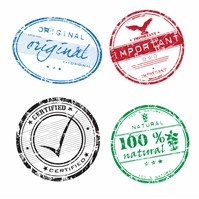
 Have you gotten into buying organic food? If so, you’re probably used to looking for the United States Department of Agriculture (USDA) certified-organic seal, since you know that means the product has passed a stringent set of organic standards. Now that you’ve turned your eye to organic personal-care products (maybe a few of the shocking studies in our posts have convinced you!), you may be looking for the same seal, but having a hard time finding it. Plus there are all those other organic seals.
Have you gotten into buying organic food? If so, you’re probably used to looking for the United States Department of Agriculture (USDA) certified-organic seal, since you know that means the product has passed a stringent set of organic standards. Now that you’ve turned your eye to organic personal-care products (maybe a few of the shocking studies in our posts have convinced you!), you may be looking for the same seal, but having a hard time finding it. Plus there are all those other organic seals.
Does it matter which one you choose?
The FDA doesn’t regulate the word “organic” in how it applies to cosmetics. The USDA regulates it, but only in terms of how it applies to agricultural products. So, if a cosmetic product wants to carry the USDA certified-organic seal, it has to meet USDA organic regulations-which were set up to apply to food! Still, in response to consumer demand, many cosmetic companies are moving to more natural, organic, agricultural ingredients (like botanical extracts), and so are applying and receiving USDA approval.
The USDA grants four different levels of “organicship:”
- 100% Organic: These products have 100% organically produced ingredients, and carry the USDA seal plus the words “100% organic.”
- Organic: These products have 95% organically grown ingredients. The remaining ones are on the “National List” of approved ingredients. Labels carry the seal and the word “organic.”
- Made with Organic Ingredients: These product contain at least 70% organically grown ingredients. Labels can say “made with organic ingredients,” but cannot carry the seal.
- Ingredient List: These products contain less than 70% organic ingredients. Labels may not display the seal or the “made with organic ingredients” phrase, but can list organic ingredients on the ingredient list.
The USDA, however, isn’t the only way to go. Cosmetic products can certify to other standards, such as foreign organic standards, eco labels, earth-friendly, etc. Ecocert, for example, offers its certification services in over 80 countries worldwide, including France, Italy, and Germany, and requires products to contain a high proportion of natural ingredients, 95% of which are cultivated using organic methods. There are several other certifiers as well, each with their own standards and seals. The lack of a comprehensive, nation-wide (or world-wide) set of standards is one thing many companies and organizations hope to correct in the near future.
According to Sustainable is Good, representatives from a number of leading companies have banded together to create a new industry standard specifically for organic cosmetics-called “OASIS” (Organic and Sustainable Industry Standards). Made specifically for cosmetics (rather than food), this label will require 85% organic ingredients for awhile, and eventually move to 95%.
For now, it can get confusing trying to tell all the labels and certifications apart. Rule of thumb: if the product carries an organic-certified seal, you can feel pretty confident that it’s safe and non-toxic to use. If it doesn’t have the seal, check the ingredient list. (Refer to our list of dangerous ingredients to avoid.) There may be organic ingredients there-just be sure there aren’t harmful ones, as well.
With a little observation, you’ll soon find it easy to detect the stuff that’s good for you. Just like you’ve learned to choose a fresh salad over a greasy double-decker hamburger, you’ll soon be selecting more nourishing cosmetics without even thinking about it-and most likely, you’ll be so pleased with the results you won’t miss the few extra pennies.
Have any tips on selecting quality organic products? Please pass them on.
Photo courtesy of Snap Village

